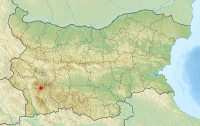 SKC Films Library SKC Films Library |
| SKC Films Library >> Fine Arts >> Architecture >> Religious Architecture |
| Rila Monastery the oldest and largest active religious center in Bulgaria Rila Monastery is situated in the southwestern Rila Mountains, 73 miles south of Sofia, in the deep valley of the Rilska River, at an elevation of 3,763 feet above sea level.
History The monastery was founded by the hermit St. John of Rila during the rule of Tsar Peter I (927-968). The hermit actually lived in a cave without any material possessions not far from the monastery's location, while the complex was built by his students, who came to the mountains to receive their education. The original complex was completely destroyed in the 13th century. A new building was constructed a few miles from the site of the first foundation, and it was completed in the 14th century thanks to the donations of Stefan Hrelyu, a powerful local prince who ordered in 1355 the construction of the tower that still bears his name and a church dedicated to John of Rila, who had in the meantime been canonized. During the Ottoman Turkish domination of Bulgaria, the monastery became a bulwark of national identity in the face of foreign occupation. It also became a destination for pilgrimages from all over the Balkan region, especially after 1469, when the relics of the saint were brought there. The complex continued to serve this function in the centuries that followed, especially in the 18th and 19th centuries, when it became one of the powerhouses of the Bulgarian Renaissance. It was destroyed by fire in 1833, and then reconstructed between 1834 and 1862 with the help of wealthy Bulgarians from across the country, under architect Alexi Rilets. The erection of the residential buildings began in 1816, while a belfry was added to the Tower of Hrelyu in 1844. Neofit Rilski founded a school in the monastery during the same period. In 1961, Rila Monastery was declared Rila Monastery National Museum. In 1976, it was declared a National Historical Reserve, and in 1983 it was included on UNESCO's List of World Cultural Heritage Sites. Rila Monastery, with the Tower of
Hrelyu (Hrelja) at the center Architecture The existing structures, with the exception of the Hrelyu Tower, date to the 19th-century building project. They occupy a vast area (approximately 2.1 acres) which forms an irregular square, provided with two entrances, both decorated with frescoes. The building that surrounds it contains four chapels, a refectory and some 300 cells, a library, and rooms for the guests of the monastery. The complex has an interior courtyard overlooked by three- and four-story constructions, embellished by orders of arches set upon stone columns. The Hrelyu Tower is a compact building 75-1/2 feet high, square in plan. The highest of its five stories contains a chapel dedicated to the Transfiguration and decorated by a series of frescoes that were done in the second half of the 14th century; in the nave are depicted stories of Saint John of Rila. Of the buildings constructed in the 19th century, the most important is the Cathedral of Our Lady of the Assumption, built in 1833 on the structure of the preceding building. Its architect was Peter Ivanovich, who worked on it in 1834-1837. The temple has five domes, three altars and two chapels. One of the most precious items inside is a gold-plated iconostasis, famous for its wood-carving, the creation of which took four craftsmen five years to complete. The wall-paintings were completed in 1846 by many masters from Bulgaria, but only Zahary Zagraph signed his paintings. The museum of the Rila Monastery is particularly famous for housing Rafail's Cross, a wooden cross made from a whole piece of wood (32×17 inches). It was whittled down by a monk named Rafail using fine burins and magnifying lenses to recreate 104 religious scenes and 650 miniature figures. Work on this piece of art lasted not less than 12 years before it was completed in 1802, when the monk lost his sight. plan of the Rila Monastery complex SOURCES |
| SKC Films Library >> Fine Arts >> Architecture >> Religious Architecture This page was last updated on 06/15/2017. |
